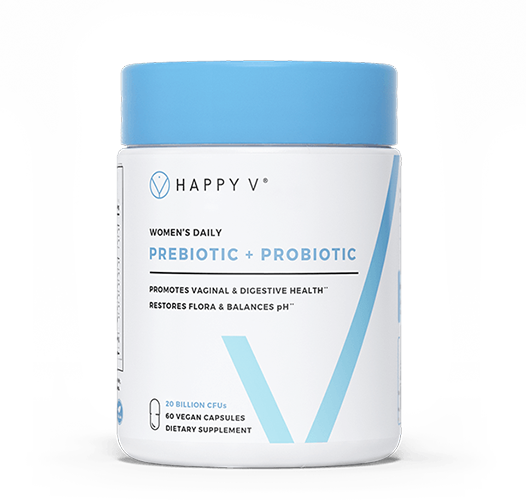- Fluconazole is an antifungal used to treat yeast infections. Unlike other kinds of antifungals, it is generally only available as a prescription.
- Fluconazole kills the fungus causing the yeast infection, and often begins to relieve symptoms like unusual discharge and itching within 24-72 hours.
- It’s important to take Fluconazole exactly as prescribed to prevent resistance and recurrence.
- Along with treating your current infection, consider how you can prevent recurrent infections by wearing breathable cotton underwear, changing clothes quickly after working out, avoiding scented soaps or body washes, and taking daily probiotics.

Vaginal discharge. Just the word can make many of us feel uncomfortable. But the truth is, a certain amount of vaginal discharge is normal and even critical for the functioning of our reproductive system, helping to flush dead skin cells and bad bacteria out of the vagina.
But what if your vaginal discharge is ACTUALLY uncomfortable? Like, a thick, cottage cheese-like consistency and itchy? In this case, you may be wondering what’s going on and how you can flush this discharge out. That’s what we are going to be talking about today. We’ll talk about what causes this unusual discharge and how the medication Fluconazole can help.
Understanding Fluconazole: An Overview

If you are experiencing thick, cottage cheese-like discharge, this is the hallmark sign of a yeast infection, and Fluconazole is an anti-fungal medication used to treat yeast infections. While many anti-fungals are available over the counter as a cream or a vaginal suppository, Fluconazole is an oral tablet that’s often prescribed by a doctor and used to treat more severe infections.
Most yeast infections are caused by the overgrowth of a particular fungus called Candida albicans. Fluconazole is particularly effective at damaging the cell membranes of fungi from the Candida species, which kills the fungus and clears the infection.
While Fluconazole is most commonly prescribed to treat yeast infections, it can also be used to treat other serious infections, like cryptococcal meningitis, or even to prevent fungal infections in people with weakened immune systems.
The Effect of Fluconazole on Yeast Infection Symptoms and Discharge
So Fluconazole helps to kill fungus, but what about those yeast infection symptoms and thick, cottage cheese-like discharge1, 2? Will Fluconazole help to flush those out?
The answer is both yes and no.
Fluconazole doesn’t “flush” the discharge out of your system. Instead, it targets the root cause, which is the overgrowth of fungus in the vagina. As Fluconazole kills the fungus, you will notice that symptoms like itching, redness, and vaginal discharge begin to subside until they are gone altogether.
When Does Fluconazole Start to Work?

When you are dealing with the symptoms of a yeast infection, particularly uncomfortable vagina discharge, you want them gone FAST. Luckily, Fluconazole does exactly that.
Most patients report symptom relief within 24 to 72 hours of taking Fluconazole. However, just because your symptoms are gone does not mean the infection has completely cleared. While Fluconazole can often be prescribed as a single pill, your doctor may prescribe a different dosage and schedule. It’s important that you follow the directions for your exact prescription and finish the full course of treatment. Don’t stop taking Fluconazole just because your symptoms have cleared, as this puts you at greater risk for reinfection.
While most people report fast symptom relief with Fluconazole, different factors, like the severity of the infection and other health conditions, may affect your exact timeline. If it has been a few days and you feel like you aren’t seeing a difference or that symptoms are getting worse, call your doctor for a reevaluation.
Prolonged Usage and Effectiveness: When Should a Second Dose of Fluconazole be Considered?
But what if the first course of Fluconazole does not resolve your yeast infection symptoms? Should you take a second?
The good news is that Fluconazole has shown to be highly effective against even severe yeast infection. However, nothing in life is 100%.
If you take your first course of Fluconazole exactly as prescribed and find you are still experiencing yeast infection symptoms or if the symptoms subside but come back in a few weeks, talk to your doctor. They may prescribe you a second dose, or they may talk to you about alternatives, as frequent or prolonged use of Fluconazole has been linked with increased likelihood of bacterial resistance and liver damage3.
If your doctor does suggest a repeat dose, talk to them about how you can work together to monitor any new symptoms that might arise and what lifestyle changes you can make to keep yeast infections from coming back.
Dealing with Recurrent Yeast Infections: Is Fluconazole the Solution?

If you are struggling with recurrent yeast infections, meaning your infections keep coming back even after taking Fluconazole, talk to your doctor about how you can break the cycle and end infections once and for all.
Generally, this involves a serious of lifestyle changes, including:
- Switching to breathable, cotton underwear
- Changing underwear and clothes promptly after working out
- Change pads and tampons frequently
- Practicing safe sex and using condoms
- Avoiding scented body washes and soaps, as they contain chemicals that can make you more prone to infection
- Increasing your probiotic intake through yogurt or vaginal probiotic supplements
Potential Side Effects and Safety Precautions when using Fluconazole

The most important thing to remember when taking Fluconazole is to finish your entire course of antifungals exactly as prescribed to prevent resistance and recurrent infections.
The second most important thing is to monitor for potential side effects. The most common side effects of Fluconazole include headache, dizziness, and upset stomach4. Though many people report these side effects are manageable, if you feel like they are severe, talk to your doctor about a potential alternative. These side effects can also be exaggerated by alcohol, which is why it’s suggested that you avoid alcohol while taking Fluconazole.
In some cases, severe allergic reactions are reported. If you ever suspect a severe allergic reaction, stop taking Fluconazole and seek immediate medical help.
Who Shouldn’t Take Fluconazole?

If you are pregnant or suspect you may be pregnant, tell your doctor when you go in, since Fluconazole is not safe for pregnant women.
Before prescribing Fluconazole, your doctor may also ask you about any pre-existing conditions or medications you may be taking. It’s important to be honest with them, since Fluconazole should not be prescribed to people with certain medical conditions or who are taking certain medications, like heart medications.
Lastly, never take Fluconazole unless your doctor has prescribed it for this exact infection. Not only can overuse of Fluconazole lead to liver toxicity, but yeast infections are easy to confuse with other common infections. The discharge associated with BV can sometimes be confused with a yeast infection, and both UTIs and yeast infections can involve stinging during urination. For these reasons, you should always see a doctor if you ever suspect any kind of infection, so they can confirm the diagnosis.
Probiotics and Vaginal Health: A Natural Approach to Preventing Yeast Infections

While Fluconazole can help you flush out a current infection, it will not help you prevent future infections.
The best thing you can do to prevent future yeast infection is focus on restoring your vaginal flora and giving it the good bacteria it needs to fight off the bad. This is where probiotics come in. Probiotics are good bacteria, and the probiotic Lactobacillus is especially important for your overall vaginal health. In the vagina, Lactobacillus releases lactic acid, which gives your vagina the slightly acidic pH it needs to kill that Candida fungus before it has the chance to cause a yeast infection5. Lactobacillus is also important within the urinary tract, making your urine slightly acidic to kill UTI-causing bacteria6.
You can get Lactobacillus probiotics naturally through foods like yogurt, but if you are struggling with severe or recurrent infections, you may want to consider a daily vaginal probiotic to ensure you are getting the probiotics you need every day to keep infections at bay and restore your vaginal health.
Achieving Optimal Vaginal Health: Happy V’s Probiotics Vaginal Health Supplement
If you do want to try a daily probiotic to prevent yeast infections, you will not be at a loss for options. But not all probiotics are created equal.
At Happy V, we are proud that our Prebiotic + Probiotic is doctor-fomulated to contain the clinically proven strains of probiotics (like that Lactobacillus probiotic!) at clinically effective doses. With higher levels of Lactobacillus, your vaginal flora will have what it needs to maintain your vaginall pH and help fight off future infection. Plus, our prebiotics serve as food for our clinically proven probiotics, making them more likely to populate in your vagina and promote your vaginal health.
Conclusion

Any sign of a vaginal infection, like unusual vaginal discharge, warrants a call to your doctor for an appointment. If your doctor finds you have a yeast infection, especially a severe one, they may prescribe you Fluconazole, which should begin to clear up uncomfortable discharge within 24 – 72 hours.
Along with treating the current infection, talk to your doctor about how you can prevent future infections through lifestyle changes and adding Happy V’s Prebiotic + Probiotic to your routine.
- Vaginal discharge: Fluid produced by glands inside the vagina and cervix, serving to remove dead cells and bacteria, keeping the vagina clean and preventing infection.
- Yeast infection: A common fungal infection caused by the overgrowth of Candida species, often resulting in thick, white discharge and itching.
- Fluconazole: An antifungal medication used to treat yeast infections and other serious fungal infections. It is usually taken orally as a pill.
- Candida albicans: The most common type of yeast that causes infections in humans.
- Antifungal: A type of medication that kills or inhibits the growth of fungi.
- Probiotics: Live bacteria and yeasts beneficial for health, especially the digestive system. In the context of vaginal health, they help maintain a healthy balance of bacteria in the vagina.
- Lactobacillus: A type of bacteria commonly found in the vagina, which helps maintain an acidic environment to prevent the growth of harmful bacteria and fungi.
- BV (Bacterial Vaginosis): A condition caused by an imbalance of bacteria in the vagina, often resulting in discharge with a fishy odor.
- UTI (Urinary Tract Infection): An infection in any part of the urinary system, including the bladder, kidneys, ureters, or urethra.
- Meena V, Bansal CL. Study to Evaluate Targeted Management and Syndromic Management in Women Presenting with Abnormal Vaginal Discharge. J Obstet Gynaecol India. 2016;66(Suppl 1):534-540. doi:10.1007/s13224-016-0879-x
- Think You Have a Vaginal Infection? Here’s What You Need to Know. The American College of Obstetricians and Gynecologists. https://www.acog.org/womens-health/experts-and-stories/the-latest/think-you-have-a-vaginal-infection-heres-what-you-need-to-know . Accessed November 24, 2023.
- Fluconazole (oral route) proper use. Mayo Clinic. April 1, 2024. Accessed May 2, 2024. https://www.mayoclinic.org/drugs-supplements/fluconazole-oral-route/proper-use/drg-20071428?p=1
- Common questions about fluconazole. NHS choices. March 9, 2023. Accessed May 2, 2024. https://www.nhs.uk/medicines/fluconazole/common-questions-about-fluconazole/
- Mashatan N, Heidari R, Altafi M, Amini A, Ommati MM, Hashemzaei M. Probiotics in vaginal health [published correction appears in Pathog Dis. 2023 Jan 17;81:]. Pathog Dis. 2023;81:ftad012. doi:10.1093/femspd/ftad012
- Kaur R, Kaur R. Symptoms, risk factors, diagnosis and treatment of urinary tract infections. Postgrad Med J. 2021;97(1154):803-812. doi:10.1136/postgradmedj-2020-139090
- A-
- A+






